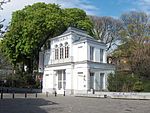Port Authority Building (Antwerp)

The Port Authority Building (Dutch: Havenhuis), or the Port House, is a government building located in Antwerp, Belgium, built between 2009 and 2016. It is located in the area of Eilandje, in the Port of Antwerp, and acts as the new headquarters of the Antwerp Port Authority, housing various departments. Designed by Iraqi-British architect Zaha Hadid, the building opened in 2016, the year of her death. It is the sole government building designed by Hadid. The design of the building incorporates the use of a fire station, integrating it into the building. Attached above and connected to the fire station is a contemporary diamond-shaped structure marked by straight edges, with an additional column providing support from the floor.The building houses approximately 500 employees, and acts as a meeting place for international contacts of the Antwerp port community. According to the Antwerp Port Authority, the building is meant to "symbolise the dynamic, reliable, ambitious and innovative nature" of the Port of Antwerp.
Excerpt from the Wikipedia article Port Authority Building (Antwerp) (License: CC BY-SA 3.0, Authors, Images).Port Authority Building (Antwerp)
Zaha Hadidplein, Antwerp
Geographical coordinates (GPS) Address Nearby Places Show on map
Geographical coordinates (GPS)
| Latitude | Longitude |
|---|---|
| N 51.24112 ° | E 4.4073495 ° |
Address
Havenhuis
Zaha Hadidplein
2030 Antwerp (Antwerp)
Antwerp, Belgium
Open on Google Maps






